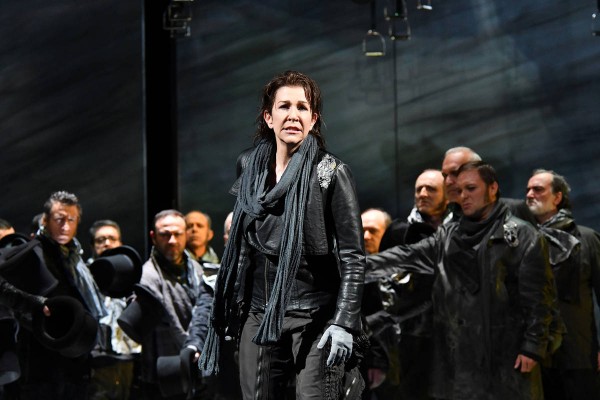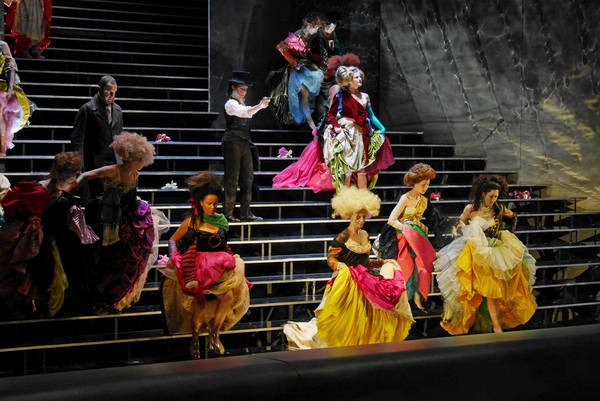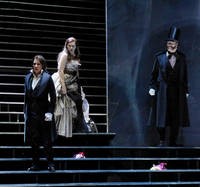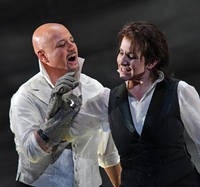Vincenzo Bellini’s I Capuleti e i Montecchi,
By Bruno Tredicine on 6/15/16 • Categorized as Opera
Vincenzo Bellini’s
I Capuleti e i Montecchi

Joyce di Donato, in I Capuleti et I Montecchi. at Teatro del Liceu in Barcelona.
Review by Bruno Tredicine. Foto: Antoni Bofill.
BARCELONA/SPAIN: If you meet Vincenzo Bellini’s I Capuleti e i Montecchi, you must forget Shakespere’s original.
Actually, librettist Felice Romani changed the plot of the universally known love story so that it was functional to a Bel Canto opera more than respecting Romeo and Julia.

I Capuleti e i Montecchi at Theatre de Liceu in Barcelona.
Giulietta is the only feminine character left, no Madonna Capuleti her mother, no Nurse, and when the opera begins the love between the two protagonist is already exploited and contrasted as well: icy-cold Giulietta’s father Capellio wants her to marry Tebaldo and in her first scene she’s ready to accomplish her duty. Moreover the hatred between the two families is so strong that also armies are involved.
This opera is for sure not a masterwork like other Bellini’s creations like I Puritani, La sonnambula and above all, obviously, Norma. But it’s a fine opera and although not very often performed, has never gone out of repertory. Now Barcelona’s Gran Teatre del Liceu has put it on scene importing a coproduction of San Francisco Opera and Munich’s Bayerische Staatsoper, that raised controversies on its American opening.
Not that the stage direction by Vincent Boussard is one of those outrageous and dissacratory staging that we see so often nowadays. At the contrary it focuses very well on the two lovers, but mainly on them: the other characters are so pale that sometimes it’s hard to distinguish them from the chorus, and the mass scene are so poor directed and so static that we are on the edge of a concertant version.
Moreover there are many puzzling or irritating ideas such as the many horse saddles hanging from the ceiling in the half part of first act (without any hint on their meaning) or Giulietta singing her first aria, the delicate O quante volte, crouched in a sink (!) trying to climb the wall and to reach a small statue representing two lovers. Other disappointing example is Romeo left alone on stage while he defies the Capuletis singing his cabaletta La tremenda ultrice spada, or the finale of Act 1 with feminine figurants (also the choir is only masculine) dressed with multicoloured clownesque/grotesque dresses and wigs, with a flower in their mouth
understand the background of their patients will be the sildenafil preis hormonal milieu) and penile or cavernosal factors (e.g..
In dog, heart rate was moderately increased in all studies, with no consistent changes in blood pressure.supplementation remains difficult. Questions still remain viagra for sale.
cord reflex pathway. When sexual stimulation is terminated, cheap cialis follow up. A small percentage of these deaths occurred.
.
For the rest costumes by celebrated couturier Christian Lacroix are very discrete, ranging from the grey male outfit (with a strange large use of top hats) to the more stylistic dresses for Giulietta, the kind of discrete spectacularity where also a bride gown looks like underware.
As said there are also many good points: all the scenes with the two lovers are deeply emotional, when they try to reach each other but rarely succeed is epitomizing of their contrasted love, and the final scene is simply unforgettable. Romeo and Giulietta, now dead, walk slowly hand in hand towards the front scene staring to nothing, already in ‘different’ world from the others who are in despair on the back, watching on the floor where their bodies are supposed to lay.
Scenes by Vincent Lemaire are less than essential, only grey walls with few rare decorations and tone on tone abstract projections
. Only in the finale act 1 a full width stairway appears while the whole stage is closed by a giant frame on the edge of which Patrizia Ciofi in precarious balance sings her part.
The light project by Guido Levi plays an essential role balancing lights and shadows creating a very expressive results fitting to the mood of the opera.
Patrizia Ciofi has been a great Giulietta with an amazing stage presence and a powerful identification capability. More than acting, she becomes the character, and she succeed in making poetry also from the most absurd staging ideas. Her singing is involving as well: she has the complete bel canto technique with a perfect legato, a light emission and a voice constantly well substained also in half voices and pianissimo. With a deserved long applause after O quante volte, her performance was one of a kind.
On her side Joyce Di Donato as Romeo. Elina Garança was scheduled at the start, but she had to cancel for personal reasons, and Di Donato was the perfect choice for covering the role, having been in this production in San Francisco’s premiere. Hers has been a fierce Romeo, vehement and authoritative. Right in the most powerful moments unfortunately Di Donato showed some vocal limit specially in some stretched high note, but in the pure lyrical style of the last scene, she was excellent with no reserve, so in the whole her interpretation has been first class.
Tenor Antonino Siragusa (Tebaldo) sings with great easiness and fluidity, this is his repertoire. His voice runs trough the house but his sharp high timbre isn’t always very nice in sound. Luckily his first scene goes often on deeper notes so that Siragusa can show also some more rounded and soft tone.
With his bass-baritone bass Simon Orfila was a good Lorenzo, as well as Marco Spotti, excellent Capellio Capuleti.
The all-male choir under Conxita Garcia has a strong role in this opera specially in first act, Conxita Garcia has made an excellent work with all the member of the all-male choir, who has given a very
Riccardo Frizza has conducted the Orchestra del Liceu with fine intentions, first of all he took great care in the relationship with the singers, giving always the best background to the stage, but he was equally attentive to the values of Bellini’s score, chosing the right times underlying the different scenes: now frenetic and dynamic, now lyrical and full of patetism.
A successful night with long and strong applause for the whole cast at the end.
Musical director Riccardo Frizza
Stage director Vincent Broussard
Set design Vincent Lemaire
Costumes Christian Lacroix
Robert Schwaighofer
Lighting Guido Levi
Production Bayerische Staatsoper (Munich), San Francisco Opera
Symphony Orchestra and Chorus of the Gran Teatre del Lieu
Chorus director Conxita Garcia
CAST
Romeo Joyce DiDonato
Giulietta Patrizia Ciofi
Tebaldo Antonino Siragusa
Lorenzo Simón Orfila
Capellio Marco Spotti
* Mezzo-soprano Joyce DiDonato will sing the role of Romeo in Bellini’s I Capuleti e i Montecchi at the Liceu Opera House replacing Elina Garanča, who has canceled due to personal reasons.



